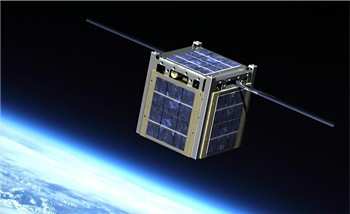Mon, Jul 15, 2013
Three Micro-Thruster Technologies Determined To Have Potential
NASA selected three proposals for the development of lightweight micro-thruster propulsion technologies that are small in size but have big potential. NASA's Space Technology Mission Directorate selected the miniaturized electrospray propulsion technologies to perform stabilization, station keeping and pointing for small spacecraft. NASA hopes these technology demonstrations may lead to similar position control systems for larger spacecraft and satellites as well.

NASA's Game Changing Development Program, managed by the agency's Langley Research Center in Hampton, Va., sponsored this solicitation and will oversee the first phase of this technology development.
The three awards selected for contract negotiations are:
- 'Microfluidic Electrospray Propulsion (MEP)' by NASA's Jet Propulsion Laboratory, Pasadena, CA.
- Miniature ElectroSpray Thrusters Based on Porous Surface Emission' by Busek Company, Inc., Natick, MA.
- 'Scalable ion Electrospray Propulsion System (S-iEPS)' by the Massachusetts Institute of Technology (MIT), Cambridge, MA.
Proposals for this solicitation were received from NASA centers, federally funded research and development centers, universities and industry. At least one electrospray technology will be selected for further development as an in-space flight demonstration through NASA's Small Spacecraft Technology Program during Phase II, which will be made through a separate solicitation.

One of NASA's priorities is to seek and develop new technologies that will radically change the capabilities for small satellites. There currently is a lack of efficient propulsion for a class of low cost, nanosatellite research spacecraft called "Cubesats," which measure about 4 inches on each side and weigh less than 3 pounds. The successful development and demonstration of these miniaturized systems will offer low mass, low-power propulsion for these small spacecraft and potentially revolutionize the future of Cubesats.
Miniaturized electrospray propulsion technologies also signal a revolutionary alternative for position control systems for larger satellites. Several studies have shown that micro-thrusters could replace currently accepted systems on large spacecraft, saving weight and space while significantly increasing mission reliability and lifetimes. This technology also could enable other game changing propulsion capabilities from micro-scale to large, deployable spacecraft structures.
More News
Also: Outlaw Prop 4 Mooney, Ready 4 Duty, Ukrainian F-16 Pilot Lost, Blue Origin Flt On his journey to become the first pilot to land solo on all seven continents, 19-year-old Etha>[...]
Also: DarkAero Update, Electric Aircraft Symposium, Updated Instructor Guide, OSH Homebuilts Celebrate The long-awaited Sonex High Wing prototype has flown... the Sonex gang tells >[...]
Discrete Code As used in the Air Traffic Control Radar Beacon System (ATCRBS), any one of the 4096 selectable Mode 3/A aircraft transponder codes except those ending in zero zero; >[...]
From 2023 (YouTube Edition): Deviation from the Historical Mean Racine, Wisconsin-based DeltaHawk is a privately-held manufacturer of reciprocating engines for aircraft and hybrid >[...]
Aero Linx: Formation and Safety Team (F.A.S.T.), USA The Formation and Safety Team (FAST) is a worldwide, educational organization dedicated to teaching safe formation flying in Wa>[...]
 Airborne 07.02.25: TikToker Arrested, Vietnam A/L Ground Hit, ATC Modernization
Airborne 07.02.25: TikToker Arrested, Vietnam A/L Ground Hit, ATC Modernization Airborne Affordable Flyers 07.03.25: Sonex HW, BlackShape Gabriel, PRA Fly-In 25
Airborne Affordable Flyers 07.03.25: Sonex HW, BlackShape Gabriel, PRA Fly-In 25 ANN's Daily Aero-Term (07.07.25): Discrete Code
ANN's Daily Aero-Term (07.07.25): Discrete Code Classic Aero-TV: DeltaHawk Aero Engine Defies Convention
Classic Aero-TV: DeltaHawk Aero Engine Defies Convention ANN's Daily Aero-Linx (07.07.25)
ANN's Daily Aero-Linx (07.07.25)




